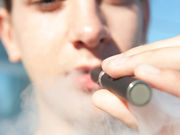Still poses serious risk to children; decrease likely in part to law requiring child-resistant packaging
MONDAY, April 23, 2018 (HealthDay News) — Pediatric exposures to liquid nicotine decreased from 2015 to 2016, but exposure still poses serious risks to children, according to a study published online April 23 in Pediatrics.
Preethi Govindarajan, from the Research Institute at Nationwide Children’s Hospital in Columbus, Ohio, and colleagues examined exposures to liquid nicotine among children aged <6 years in the United States using data from the National Poison Data System for January 2012 through April 2017.
The researchers found that during the study period, 8,269 liquid nicotine exposures among children aged younger than 6 years were reported to U.S. poison control centers. Overall, 92.5 percent of children were exposed through ingestion; 83.9 percent of the exposures occurred in children aged younger than 3 years. Overall, 35.1 and 1.4 percent of the exposed children were treated and released from a health care facility and were admitted, respectively. From 2012 to 2015, there was an increase in the annual exposure rate per 100,000 children, from 0.7 to 10.4; there was a subsequent decrease to 8.3 in 2016. Comparing the nine months before with the nine months after the federal child-resistant packaging law went into effect, there was a significant decrease in the mean number of exposures among states without a preexisting law requiring child-resistant packaging, averaging 4.4 fewer exposures per state after law implementation.
“Liquid nicotine continues to pose a serious risk for young children,” the authors write. “Additional regulation of these products is warranted.”
Copyright © 2018 HealthDay. All rights reserved.








